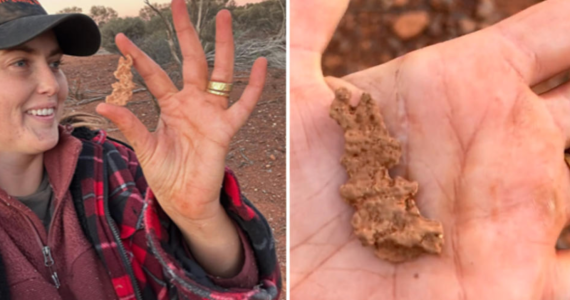Aussie stumbles upon ‘lot rarer’ $2,500 outback find
By
- Replies 4
Outback exploration is always a thrilling affair and makes for some amazing sightseeing.
Its rugged terrains, wildflowers, clear night skies, and native wildlife all have a special appeal that captivates visitors seeking to get away from the cares of city life.
But there's another outback secret that's even more captivating: its potential for unearthing hidden treasure.
This was recently the case for Tyler Mahoney, daughter of a well-known gold prospector and the star of the TV show Gold Rush.
On a recent outback adventure with her father, Tyler watched in delight as her dad made a very unexpected discovery worth an eye-popping $2,500.
'So my Dad made $2,500 before breakfast,' Tyler revealed on social media. 'Can you spot it?'
Attached to the post was an image of the outback landscape where they had been digging, covered in stones, red earth, and shrubs. But beneath the surface was an irregularly shaped alluvial gold nugget.
The discovery of this nugget by the Mahoney family is a testament to the intricate geological processes at play in the region.
Alluvial gold nuggets, like this one, are unique in that they have been transported away from their original source by natural forces, such as erosion and sedimentation, often over vast distances.
This fascinating geological phenomenon adds an extra layer of intrigue to the already captivating world of gold prospecting in the outback.
In June, the gold prospector and her family had been equally successful when they used an excavator to scrape the ground. Their efforts at that time yielded a two-ounce discovery worth a whopping $7,000.
According to Tyler, the Mahoney family have been part of the gold prospecting scene for four generations and owns a gold mining tenement near Kalgoorlie in Western Australia.
With the area's gold rush now over 130 years old, Tyler claims it's becoming harder and harder to find large nuggets.
'Mostly big ones are getting a lot rarer, we call it a bonus nugget,' she explained in an earlier interview.
'It's hard getting access to ground that hasn't already been mined or prospected. Compared to like, 60 years ago, they were bloody lying everywhere.'
Fortunately for the entities involved, gold is currently valued at a very respectable $2,974.24 per ounce—even if finding nice, large pieces of it is becoming increasingly more difficult.
Gold prospecting in Australia has an illustrious history. It all began in 1851 when a prospector named Edward Hargraves discovered a small piece near Bathurst in New South Wales.
This led to what is now famously known as the Australian Gold Rush, a pivotal event in the shaping of modern Australia.
Many of the methods used in the 19th century to hunt for gold are strikingly similar to those used today.
Panning, the most traditional method, involves dipping a pan into a river and shaking it to reveal any golden particles on the bottom.
More advanced tools like metal detectors, sluices, and dredges were later introduced, making the prospect of unearthing a shiny nugget all the more feasible.
This vast, unpredictable terrain continues to yield treasures, unearthing secrets etched deep within its red soil.
Whether it's a gold nugget, a rare gemstone, or simply an unforgettable adventure—the Outback promises an experience like no other, as rich and alluring as gold itself.

What are your thoughts on the Mahone family’s find? Would you recommend an outback tour to someone you know? Let us know what you think in the comments below!
Its rugged terrains, wildflowers, clear night skies, and native wildlife all have a special appeal that captivates visitors seeking to get away from the cares of city life.
But there's another outback secret that's even more captivating: its potential for unearthing hidden treasure.
On a recent outback adventure with her father, Tyler watched in delight as her dad made a very unexpected discovery worth an eye-popping $2,500.
'So my Dad made $2,500 before breakfast,' Tyler revealed on social media. 'Can you spot it?'
Attached to the post was an image of the outback landscape where they had been digging, covered in stones, red earth, and shrubs. But beneath the surface was an irregularly shaped alluvial gold nugget.
The discovery of this nugget by the Mahoney family is a testament to the intricate geological processes at play in the region.
Alluvial gold nuggets, like this one, are unique in that they have been transported away from their original source by natural forces, such as erosion and sedimentation, often over vast distances.
This fascinating geological phenomenon adds an extra layer of intrigue to the already captivating world of gold prospecting in the outback.
In June, the gold prospector and her family had been equally successful when they used an excavator to scrape the ground. Their efforts at that time yielded a two-ounce discovery worth a whopping $7,000.
According to Tyler, the Mahoney family have been part of the gold prospecting scene for four generations and owns a gold mining tenement near Kalgoorlie in Western Australia.
With the area's gold rush now over 130 years old, Tyler claims it's becoming harder and harder to find large nuggets.
'Mostly big ones are getting a lot rarer, we call it a bonus nugget,' she explained in an earlier interview.
'It's hard getting access to ground that hasn't already been mined or prospected. Compared to like, 60 years ago, they were bloody lying everywhere.'
Fortunately for the entities involved, gold is currently valued at a very respectable $2,974.24 per ounce—even if finding nice, large pieces of it is becoming increasingly more difficult.
This led to what is now famously known as the Australian Gold Rush, a pivotal event in the shaping of modern Australia.
Many of the methods used in the 19th century to hunt for gold are strikingly similar to those used today.
Panning, the most traditional method, involves dipping a pan into a river and shaking it to reveal any golden particles on the bottom.
More advanced tools like metal detectors, sluices, and dredges were later introduced, making the prospect of unearthing a shiny nugget all the more feasible.
This vast, unpredictable terrain continues to yield treasures, unearthing secrets etched deep within its red soil.
Whether it's a gold nugget, a rare gemstone, or simply an unforgettable adventure—the Outback promises an experience like no other, as rich and alluring as gold itself.
Key Takeaways
- A gold nugget worth $2,500 was found in the outback by the father of gold prospector and TV personality Tyler Mahoney.
- The nugget is known as an alluvial gold nugget, indicating that it has moved from its primary source due to earth movement.
- The Mahoney family have been gold prospectors for four generations and found a $7,000 nugget in June after excavating the ground.
- Despite their recent findings, Ms Mahoney says it is becoming increasingly difficult to find larger nuggets due to the mining town they live and work in over 130 years old and having extensively mined and prospected land.
- The 1851 Gold Rush changed Australia and influenced how it is today. The ways people searched for gold back then, like panning, are quite still used today.
What are your thoughts on the Mahone family’s find? Would you recommend an outback tour to someone you know? Let us know what you think in the comments below!








